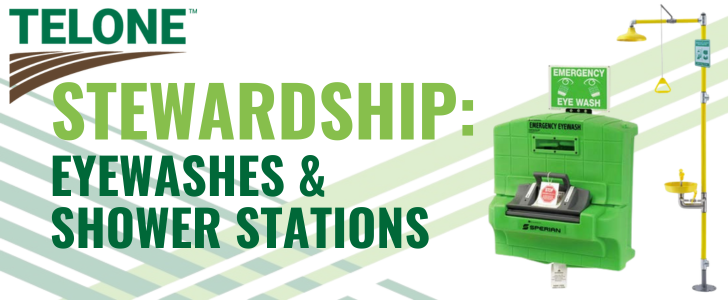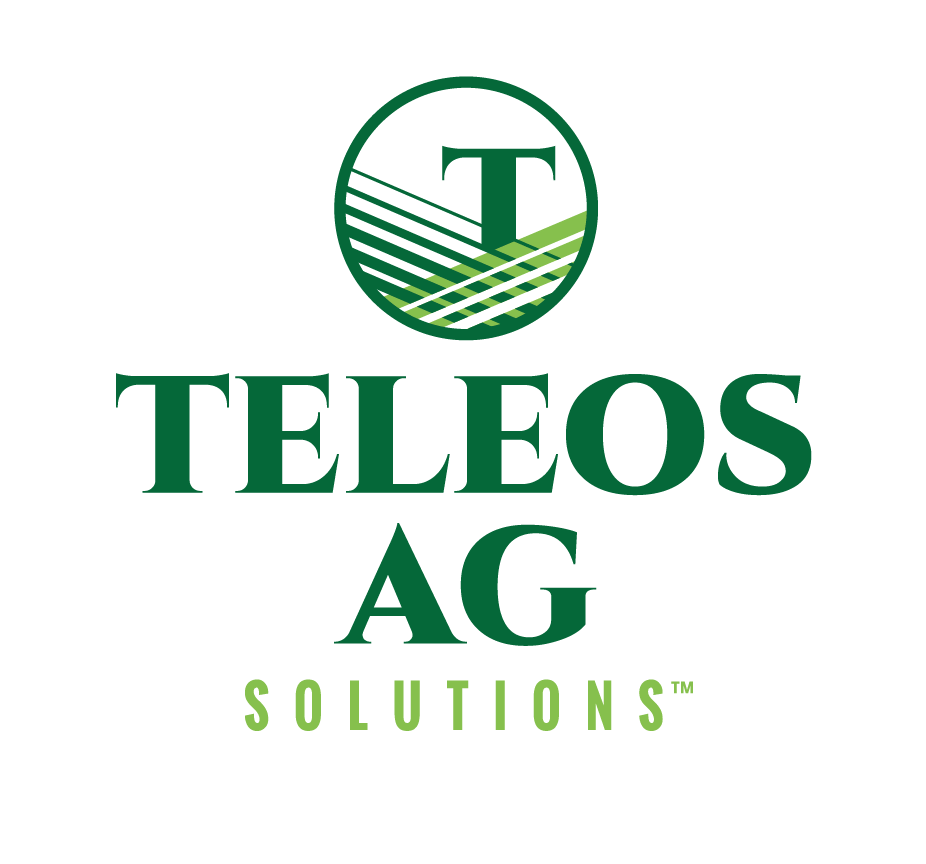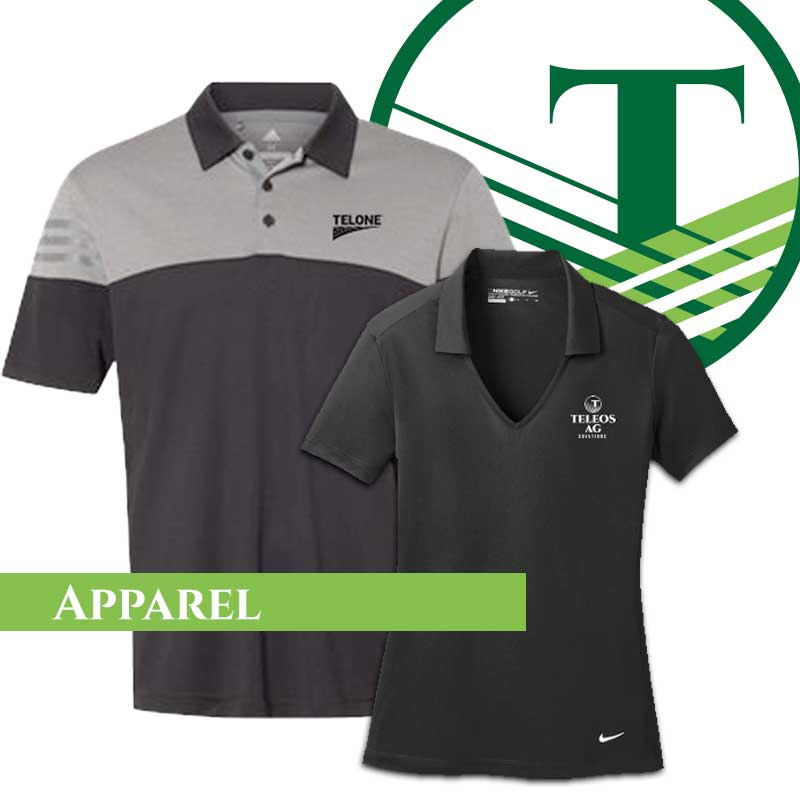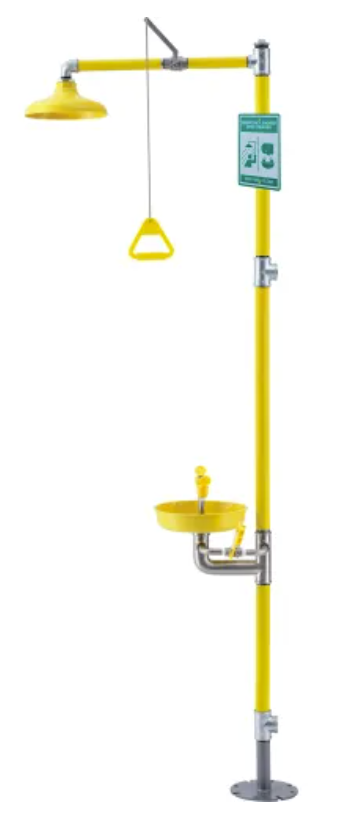
If you are an employer who deals with hazardous materials, you have a responsibility to ensure the safety of your employees. We understand that complying with TELONE™ handler safety regulations can be challenging. Teleos is here to help. This blog post covers the emergency eyewash and safety shower facilities that are necessary at your bulk facility. Although OSHA does not mandate these facilities specifically for TELONE™ II, the EPA Worker Protection Standard, TELONE™ SDS, and TELONE™ Storage and Handling Guide have set standards for emergency rinse water. Please read on as we guide you in selecting the appropriate equipment to protect your employees. You can also download a copy of this information in a convenient Tip Sheet, here.
BE SAFE & COMPLIANT
Selecting eyewash and safety shower systems forces bulk site operators to consider legal requirements, best practices to support employee safety, how to minimize liability for the company, and requirements from the product registrant. This process includes deciding what features are required vs. desired, the location, training, testing, and documentation.
While OSHA does not specifically require emergency eyewash and shower facilities for TELONE™ II sites, the EPA Worker Protection Standard has minimum requirements for an eye flush capability. Further, the TELONE™ II Safety Data Sheet and the TELONE™ Storage & Handling Guide call for eye and skin flushing capability. has minimum requirements for an eye flush capability. Further, the TELONE™ II Safety Data Sheet and the TELONE™ Storage & Handling Guide call for eye and skin flushing capability.
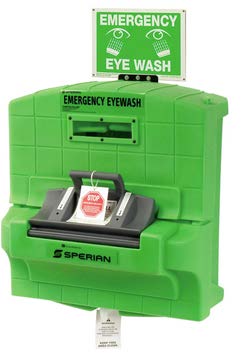
At a minimum, TELONE™ bulk site operators must have an eyewash station that complies with the EPA Worker Protection Standard, as well as a shower capability that allows washing exposed skin with plenty of water for 15-20 minutes. Selecting systems which comply with the ANSI Z358.1 standard are the preferred way to assure full compliance.
KEY TERMS
OSHA: 29 CFR 1910.151(c) requires facilities to provide equipment for quick drench or flushing of the eyes and body where persons may be exposed to “injurious corrosive materials”. TELONE™ II fumigant is not classified as corrosive for OSHA purposes, and therefore is not subject to the explicit OSHA requirement for eyewash and showers. OSHA does have a general duty clause (29CFR 1910.1200) that requires employers to provide safety equipment suitable for use and emergency response, but limits application of that clause to only where there is no standard that applies to a particular hazard.
EPA: The preamble of the EPA Worker Protection Standard specifically notes that the final rule does not require employers to provide shower facilities. However, the WPS includes eye flush requirements in 40 CFR 170.509(d). It requires that employers “Provide a system capable of delivering 0.4 gallons/minute for 15 minutes, or 6 gallons of water able to flow gently for about 15 minutes at a mix/load site if handlers use products requiring eye protection or use a pressurized closed system.”
SDS: Further, the TELONE ™ II Safety Data Sheet (SDS) calls for washing exposed skin with soap and plenty of water for 15-20 minutes. Persons with eye contact are called to hold eyes open and rinse slowly and gently with water for 15-20 minutes. The SDS also says a suitable emergency safety shower facility should be immediately available.
STORAGE & HANDLING GUIDE: This guide calls for an eye wash and safety shower accessible from work areas. It also states that personnel must know the location and how to use them.
STATE REGULATIONS: States may implement and enforce safety requirements which are more stringent than federal requirements. Operators must be aware of state regulations.
Why is the ANSI/ISEA Z358.1 Standard Important?
A standard does not carry the force-of-law unless it is specifically adopted in a regulation. However, this standard is widely recognized as the ultimate in best-practices for eyewash and emergency shower design. While OSHA does not specify ANSI/ISEA Z358.1 as standard, the agency accepts the standard as a means of complying with 29 CFR Part 1910.151(c). OSHA’s standard letters of interpretation support the agency’s recognition of the standard. Site operators can be confident of compliance if they purchase and maintain systems rated to meet ANSI Z3358.1.
ANSI STANDARD DESIGN
Key elements of the ANSI Standard Z358.1 include minimum performance, testing, installation, maintenance and training specifications for equipment and systems used for emergency treatment of the eyes or body of a person who has been exposed to injurious materials. It covers plumbed and self-contained emergency showers and emergency eyewash equipment, eye/face wash equipment, combination units, personal wash units and hand-held drench hoses.
Key elements include:
- PLACEMENT: In most cases, units should be located within 10 seconds of the potential hazard. ANSI says the average person walks about 55 feet in 10 seconds, for a frame of reference on desired placement of equipment/stations.
- ACCESSIBILITY: Units should be accessible and on the same level as the hazard. The path must be free of obstructions. The unit must be well-lit and have a highly visible sign.
- HEIGHT: eyewash or eye/face wash heads to be located 33-45 inches above the floor; 82-96 inches for drench shower or combination drench shower/eyewash shower heads.
- ACTIVATION: The eyewash must begin flushing within 1 second; flush both eyes at once. Have hands-free stay-open valves so hands can be used to hold open eyelids while flushing.
- FLOW: Eyewash stations must have a minimum flush rate of 0.4 gpm for 15 minutes. Drench showers must have a minimum of 20 gpm at 30 psi.
- PATTERN: Drench shower flow patterns should be a minimum of 20 inches wide at 60 inches above the floor.
- TEMPERATURE: Tepid water required. The appendix defines tepid as between 60-100°F for the full fifteen-minute shower-use cycle.
- TESTING: Weekly activation of plumbed eyewashes to verify operation and flush contaminants such as bacteria or mold.
Z358.1-2004 (American National Standard for Emergency Eyewash and Shower Equipment) is available from ISEA (International Safety Equipment Association) https://safetyequipment.org.
Download and print the Eyewash & Shower Safety Tip Sheet, here.
NOTICE: The information, procedures, methods, and recommendations herein are presented in good faith and are believed to be accurate and reliable as of the publication date but may well be incomplete and/or not applicable to all conditions or situations. No representation, guarantee, or warranty is made as to the accuracy, reliability, or completeness of said information, procedures, methods, and recommendations. Nor is any representation, guarantee, or warranty made that application or use of any of the same will avoid hazards, accidents, losses, damages, or injury of any kind to persons or property, or give desired results, or that the same will not infringe patents of others. Nor does the information, procedures, methods, and recommendations herein represent the views of any organization or person other than that of the author unless explicitly noted. Readers must satisfy themselves as to the suitability of said information, procedures, methods, and recommendations prior to use.
Disclaimer:
The resources and information provided are meant purely for educational discussion, contains only general information about legal matters, and is not to be construed as advice. Please note that any information or resources provided are not legal or regulatory advice, and should not be treated as such. You must not rely on the information provided as an alternative to legal advice from your attorney or other professional services. Teleos Ag encourages readers to consult with counsel, and their local, county, and state regulators. We make no representations or warranties, express or implied, in relation to the information provided through our resources and blog posts. It is the readers responsibility to know the laws related to 1,3- D, appropriate PPE, Licensing, etc., in his or her City, County, State, and Country.
- EQUIPMENT COMPATIBILITY: METAL SELECTION FOR TELONE™ by TELEOS SOIL FUMIGANT - December 16, 2025
- STORAGE SECURITY FOR TELONE™ by TELEOS - October 16, 2025
- TIP SHEET: PLACARDING FOR BULK SHIPMENT RETURNS - August 15, 2025
